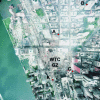Air levels of carcinogenic polycyclic aromatic hydrocarbons after the World Trade Center disaster
- PMID: 15280534
- PMCID: PMC511010
- DOI: 10.1073/pnas.0404499101
Air levels of carcinogenic polycyclic aromatic hydrocarbons after the World Trade Center disaster
Abstract
The catastrophic collapse of the World Trade Center (WTC) on September 11, 2001, created an immense dust cloud followed by fires that emitted soot into the air of New York City (NYC) well into December. The subsequent cleanup used diesel equipment that further polluted the air until the following June. The particulate air pollutants contained mutagenic and carcinogenic polycyclic aromatic hydrocarbons (PAHs). By using an assay developed for archived samples of fine particles, we measured nine PAHs in 243 samples collected at or near Ground Zero from September 23, 2001, to March 27, 2002. Based on temporal trends of individual PAH levels, we differentiated between fire and diesel sources and predicted PAH levels between 3 and 200 d after the disaster. Predicted PAH air concentrations on September 14, 2001, ranged from 1.3 to 15 ng/m(3); these values are among the highest reported from outdoor sources. We infer that these high initial air concentrations resulted from fires that rapidly diminished over 100 d. Diesel sources predominated for the next 100 d, during which time PAH levels declined slowly to background values. Because elevated PAH levels were transient, any elevation in cancer risk from PAH exposure should be very small among nonoccupationally exposed residents of NYC. However, the high initial levels of PAHs may be associated with reproductive effects observed in the offspring of women who were (or became) pregnant shortly after September 11, 2001. Because no PAH-specific air sampling was conducted, this work provides the only systematic measurements, to our knowledge, of ambient PAHs after the WTC disaster.
Figures



References
-
- Chen, L. C. & Thurston, G. (2002) Lancet. 360, Suppl., s37–s38. - PubMed
-
- Dalton, L. (2003) Chem. Eng. News. 81, 26.
-
- McCallister, T. (2002) World Trade Center Building Performance Study: Federal Emergency Management Agency Report 403 (Federal Emergency Management Agency, Washington, DC).
Publication types
MeSH terms
Substances
Grants and funding
LinkOut - more resources
Full Text Sources
Medical

